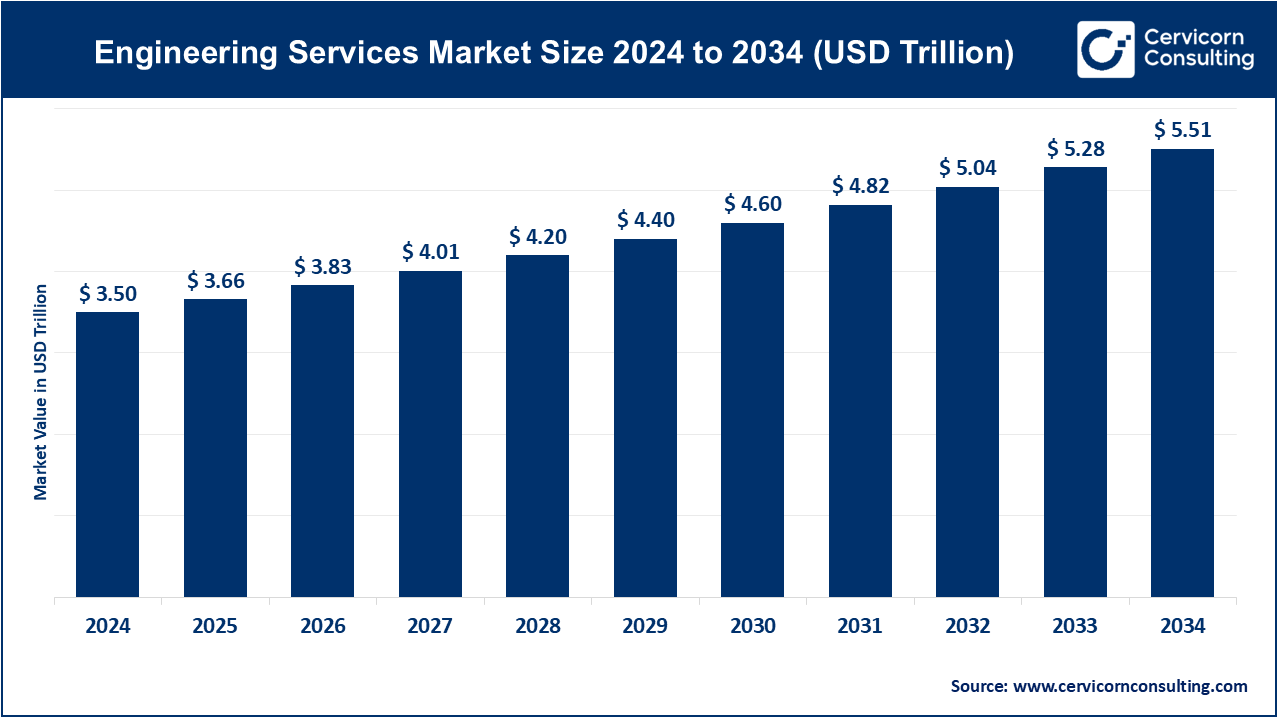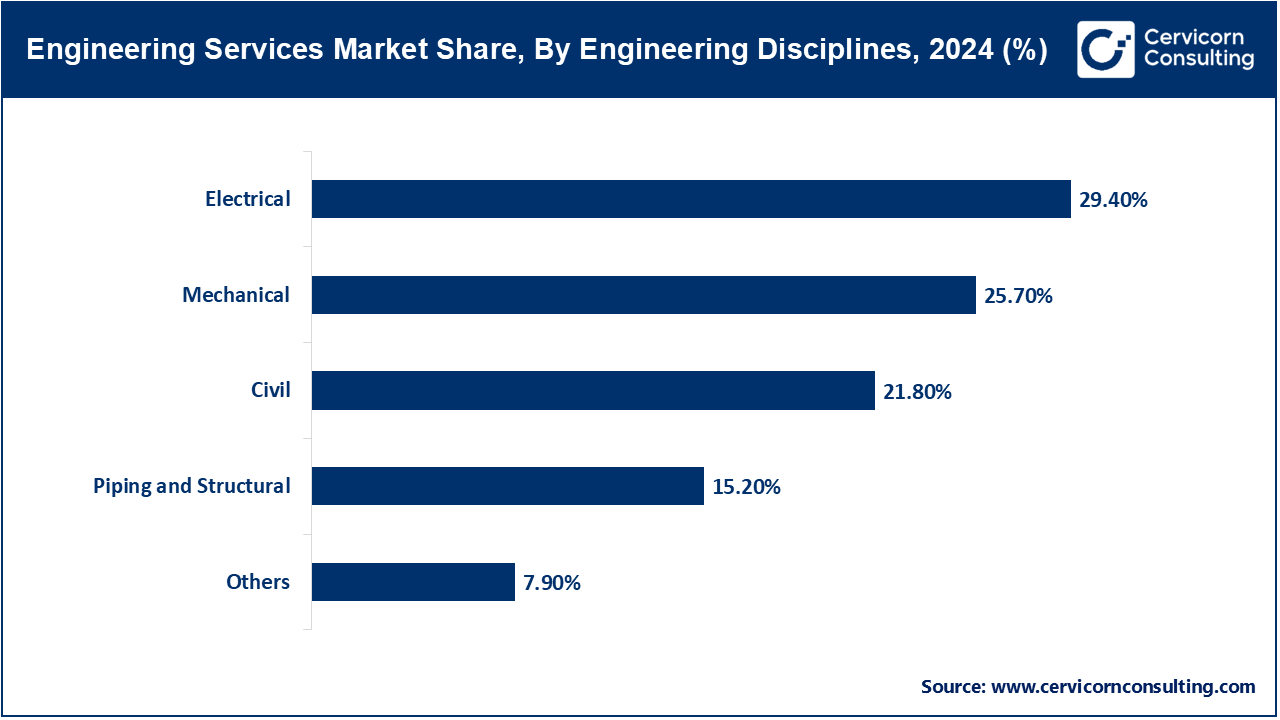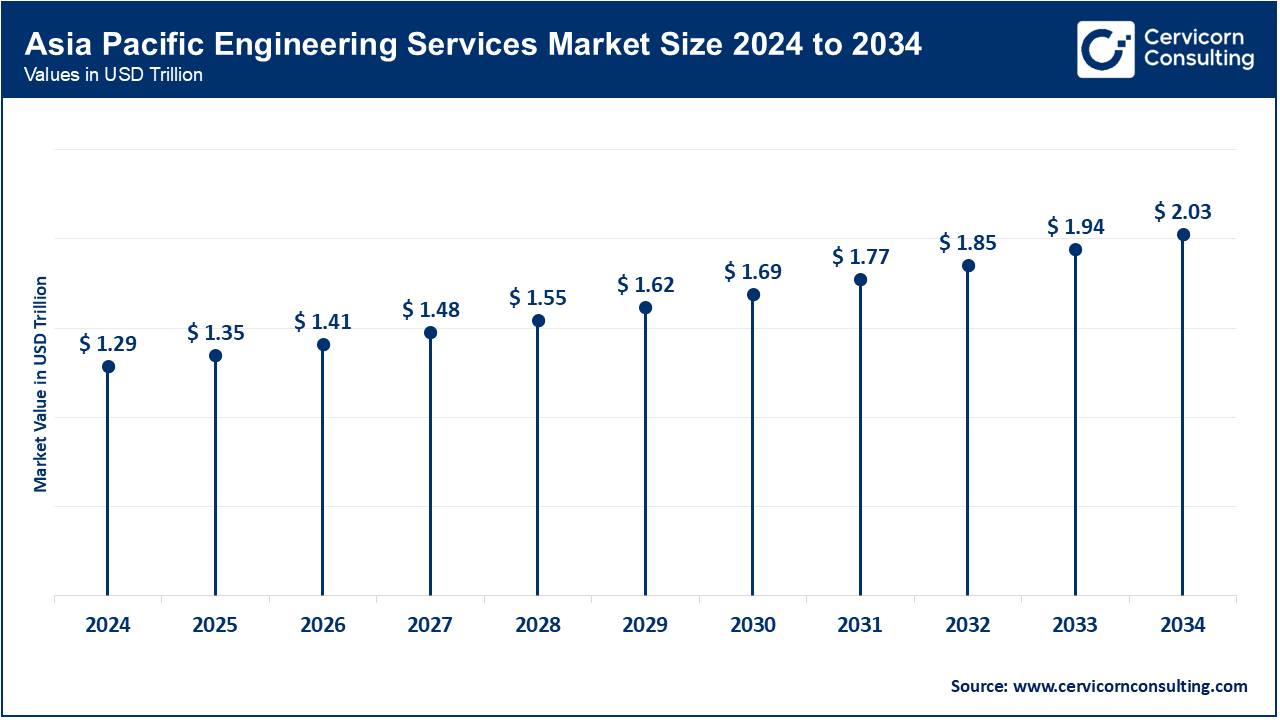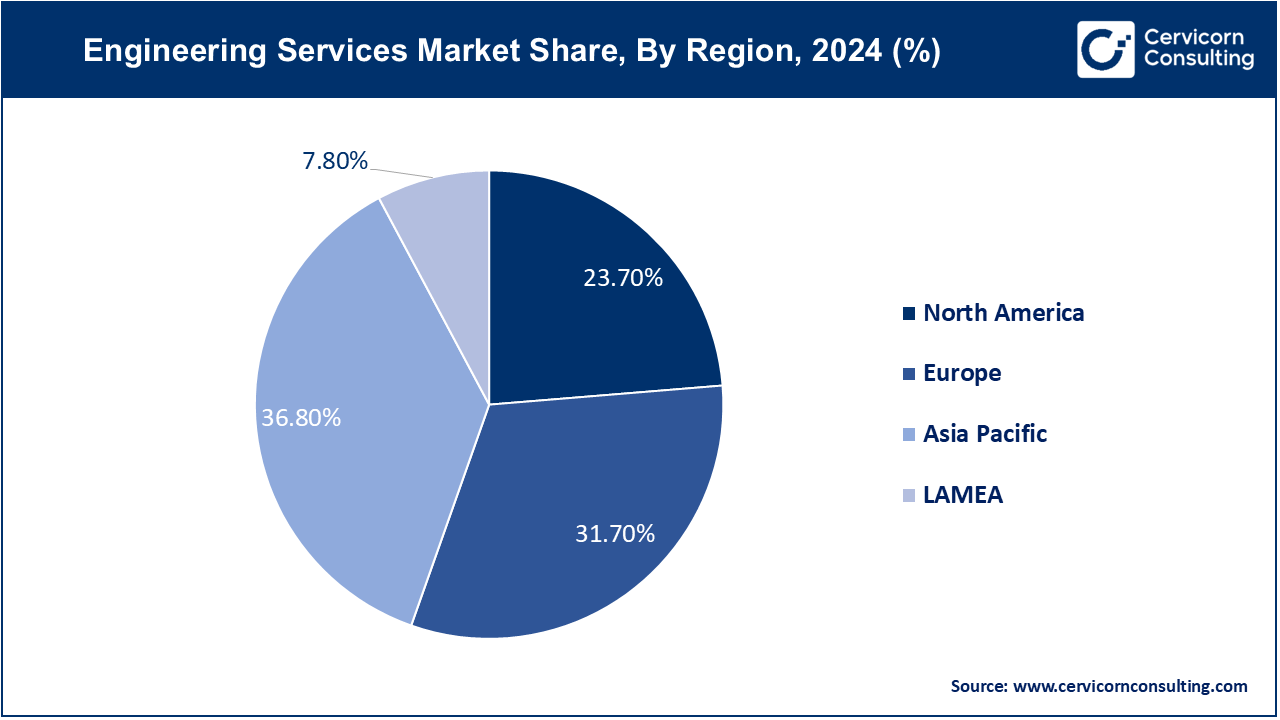The global engineering services market size was valued at USD 3.50 trillion in 2024 and is expected to hit around USD 5.51 trillion by 2034, growing at a compound annual growth rate (CAGR) of 4.64% from 2025 to 2034.
The engineering services market is experiencing rapid expansion due to the increasing demand for innovative solutions across various industries. Companies are relying on engineering expertise to develop efficient, sustainable, and technologically advanced products and infrastructure. Key industries driving this demand include aerospace, automotive, IT, telecommunications, and construction. The rise of smart cities, renewable energy projects, and advanced manufacturing techniques has further amplified the need for specialized engineering services. Additionally, the growing trend of outsourcing engineering tasks to reduce costs and access global talent has significantly impacted the market. With digitalization reshaping industries, services such as software development, system integration, and automation have become critical. Between April 2022 and March 2023, India's engineering goods & Services exports were significant, with Maharashtra exporting USD 72.5 billion, primarily in engineering goods, accounting for 16.60% of the country's total exports.

Engineering services involve the application of technical knowledge, skills, and creativity to design, develop, and maintain various systems, products, or infrastructure. These services span a wide range of industries, including construction, manufacturing, aerospace, automotive, and technology. Examples include designing buildings, developing new machines, creating software systems, and improving production processes. Engineering services can also include consulting, project management, and testing to ensure that solutions are efficient, safe, and sustainable. Professionals in this field often specialize in areas such as civil, mechanical, electrical, or software engineering, using advanced tools and methods like CAD (Computer-Aided Design) and simulations. Their work plays a crucial role in solving real-world problems and driving innovation.
Report Scope
| Area of Focus | Details |
| Market Size in 2025 | USD 3.66 Trillion |
| Projected Market Size by 2035 | USD 5.51 Trillion |
| Growth Rate | CAGR of 4.64% from 2025 to 2034 |
| Largest Revenue Holder Region | Asia Pacific |
| Fastest Growing Region | North America |
| Segment Coverage | By Engineering Disciplines, Delivery Model, Service, Industries and Regions |
Increased Investment in Research and Development (R&D)
The rapid pace of technological advancement requires substantial investment in new tools, software, and infrastructure. Innovation and keeping a competitive advantage have compelled firms to invest a lot in research and development. This leads to an increased need for engineering services that facilitate the creation of new technologies, products, and processes. Engineering firms are important in appreciating research and coming up with applications and solutions.
Growth in Renewable Energy Sector
Moving away from the traditional sources of energy to the likes of solar, wind, and even hydropower is the other main driver for the growth of the engineering service market. There is a need for engineering companies to design, construct, and refine systems and facilities for power generation from renewables in response to this global trend which reduces dependence on environmentally unfriendly sources of energy.
Shortage of Skilled Workforce
High Cost of Technology Implementation
Adoption of Modular and Prefabricated Construction:
Integration of Advanced Simulation and Modelling Tools
Managing Data Security and Privacy
Adapting to Rapid Technological Changes
Civil Engineering: As a branch of engineering, civil focuses on the infrastructure design, construction and preservation including roads, bridges and buildings. It includes emerging railways and smart infrastructure technology, green building construction, and advanced materials and techniques. The depletion of available space in cities where a certain level of civil infrastructure is focused increases the supply of civil engineering problem solving.

Mechanical Engineering: In mechanical engineering, mechanical systems and devices including engines, machines, and mechanical systems such as HVAC are designed and manufactured. These trends involve the use of robotics, the Internet of Things, and high-performance materials. The factors advocating for a well-efficient energy system towards industrialization and provision of mechanical engineering services are on the upward surge.
Electrical Engineering: This branch of engineering concerns itself with designing and constructing electrical systems such as power generation systems, transmission systems and distribution systems. Innovations in renewable energy sources, smart grid technology and infrastructure for electric vehicles are amongst the recent improvements in this sector. The upsurge in electrical engineering services is due to the increasing demand for energy efficiency improvements and the adoption of more digital systems in different processes.
Piping and Structural: Piping and structural engineering comprises of piping system and any structures supporting the piping systems within industries such as oil and gas and construction industrial spaces. Incorporation of modern materials and technology has brought efficiency and safety through, for example, use of computerized designs and technology. The increasing number of construction projects and expansion of infrastructures creates an opportunity in this sector.
Others: The “Others” category encompasses niche engineering fields including, but not limited to, the aerospace and the environmental and chemical engineering. These trends show a strong orientation towards the issues of sustainability, design methods more advanced than the traditional ones, and application of new materials. The growth of such sectors as aviation and environmental management creates the demand for new engineering services due to the complex nature of the work and new technologies that are emerging.
Offshore: It includes executing engineering services from a different country than the client’s, commonly to cut down costs and also source for specialized skills. Trends include the growing dependency on remote teams and technology to oversee the management of the teams. This model is on the rise because it is cost effective and allows sourcing of skills from different parts of the world without any geographical limitation.
Onsite: Onsite delivery models refer to the situation where engineering services are carried out at the client’s site especially for the purpose of teamwork and resolving issues at hand without delay. Trends include more client interaction and modifying projects according to the client’s wishes. This model often has advantages especially where a project is vast complex and requires full-time attention, because it helps make strong ties with the clients and offers solutions that suit their requirements.
Product Engineering: It constitutes the ideation, design, development, and launch of new products at the market. The trends in this discipline includes development of smarter products through use of advanced technologies such as AI and IoT, application of digital twins for conjoining ideas and concepts to produce prototypes and increased focus towards green design due to regulatory and consumer demands.
Process Engineering: Process engineering specializes in the design and management of ways to improve process efficiency and product quality. Current trends focus on integrating automation and digital means of operation to lessen the workloads, lean manufacturing maximization, as well as employing data analytics to watch and control processes in real time.
Automation Related Services: The automation related services include the implementation and maintenance of the automated systems for enhancing the operational efficiency. Nowadays, these include deployment of robots, artificial intelligent automation, and the fourth industrial revolution concepts where there are cyber-physical systems. There is also a rise in demand for a user-defined automation concept especially for developed industries and the improvement of self-operating systems.
Asset Management Related Services: The services relating to asset management consist of proper implementation and utilization of physical and virtual assets within their life span. The trends are the use of digital twins for asset tracking, AI based predictive maintenance and use of the internet of things for better management of assets. These services apply to limit the asset costs while maximizing the efficiency of the operations.
Others: The “Others” category involves other specialized engineering services such as agricultural engineering, structural engineering, and project management consulting. Trends in these areas include changes in strategies due to emphasis on environmental sustainability, occupational safety, and regulatory compliance, and integration of modern science and information technology in the specialized areas. This part of the market highlights the versatility of engineering services offered to different sectors and the increasing need for customized solutions.
Aerospace and Defense: The provision of engineering services within the aerospace as well as defense industry encompasses aircraft, spacecraft and their respective weapons systems design, development and maintenance activities. The trends associated with it include the use of better composite materials, the robotics in aerospace and system autonomics. There is emphasis on safety and performance capabilities and operational effectiveness while adhering to the regulations and fostering defensive technologies.
Automotive: The engineering services offered within the automotive industry include the design of vehicles and product testing as well as support during the manufacturing process. Important trends are associated with the introduction of electric vehicles (EVs), advancements in vehicle self-driving technology, and smart manufacturing technologies. The sector is also enhancing fuel efficiency and reducing emissions while integrating advanced driver assistance systems (ADAS).
Chemical and Petrochemical: The chemical and petrochemical engineering field involves engineering services that include the design of a plant, facilitating the process and maintaining machinery. Key trends are the shift to more cost effective and environment friendly processes, improvement in plastics and other recyclables, and application of digital twins technology to facilitate monitoring. The sector has objectives of minimizing its negative effects on the environment while operational efficiency is increasing.
Electric Power Generation: The scope of engineering services associated with electric power generation encompasses the design, development, and upkeep of power generation plants and their supporting systems. Increasingly, the use of non-conventional energy sources like solar and wind, modernization of grids and the use of smart grid technologies are on the increase. The aim is on making energy generation more effective, dependable, and eco-friendly.
Municipal Utility Projects: These Municipal utility projects include engineering design services devoted to the provision of water, waste disposal, and other services to urban centers. Trends comprise the use of smart technologies in cities, the practice of water recycling and conservation and building infrastructures that are climate change resilient. The primary focus of the sector is to ensure sustainable urban development that is characterized by enhanced service delivery.
Mining: Mining engineering is comprised of services offered in relation to exploration, design and planning of mines and their operations. Trends emphasize on more automation, safety improvement by introducing better observation techniques for deeper ground mining and safe environmental practices/methods. The impact on the environment of the processes of production is being investigated, and methods of raw material obtaining are working more effectively.
Oil and Gas: Concerning the oil and gas domain, engineering services include, but are not limited to, exploration activities, drilling operations, and production processes of the located oil reserves. These include digital oilfields technologies, new drilling practices, as well as measures to enhance environment protection. The industry is concentrating on enhancement of the production systems whilst decreasing the cost of production in global markets and high volatility of the prices in certain periods.
Transportation: Activities under engineering services in transportation include designing and managing infrastructural works such as roads, rail and bridge systems. Smart transportation systems, electric and autonomous vehicles, and advanced strategies for traffic control belong to the latest technological developments today. Moreover, there is a growing concern towards safety, efficiency and ecology of the wheeled transportation networks.
Others: The "Others" section represents a variety of sectors spanning from the chemical medicine industry to the creation of buildings and structures within which engineering services are offered additionally. The trends depend on the expected growth rate of each sector but most usually cover digital transformation, orientation to sustainability and tackling the issues with creative ideas. This section indicates engineering services are not only restricted within a discipline but also serve the ever-changing needs in distinct areas.
The Asia Pacific engineering services market size is calculated at USD 1.29 trillion in 2024 and is projected to grow around USD 2.03 trillion by 2034 with a CAGR of 4.7%. The growing engineering services sector in Asia-Pacific is driven today primarily by industrialization and urbanization of the region. These include megaprojects like building high-speed rail for smart cities, and investments in clean energy and factories. The region is also making progress in its digital arm even with the likes of AI and IoT whose aim is to boost GDP and cities development.

North America market size is expected to reach around USD 1.31 trillion by 2034 increasing from USD 0.83 trillion in 2024 with a CAGR of 5.23%. In North America, the diagnosis of the engineering services market shows that it is driven by technological advancement and growth in infrastructure. Among the trends include heavy funding of smart cities and environmentally friendly building activities, development of self-driving as well as electric cars, and the digital change across sectors. Region, further, aims at improving the resilience and efficacy of the energy and utilities.

The Europe engineering market size is measured at USD 1.11 trillion in 2024 and is expected to grow around USD 1.75 trillion by 2034 with a CAGR of 4.81%. European market focuses more on the regulatory aspects and green development. They include the use of clean energy technologies as well thanks to the circular economy, and the use of more advanced energy saving in building design. The region is also quite ambitious in terms of strict environmental protection and application of innovations into the public and transport infrastructure, systems.
The LAMEA market size is forecasted to reach around USD 0.43 trillion by 2034 from USD 0.27 trillion in 2024. The engineering services market in LAMEA, on the other hand, presents a mixed bag of unique challenges and opportunities. Trends include the focus on market restructuring and more investments in infrastructure and urbanization especially among the developing countries. Attention is also given to the energy and water management systems through the application of new technologies to solve utility service problems and the enhancement of economic growth through better information communication infrastructure.
New players like Tetra Tech, Inc. and Ramboll Group A/S are driving innovation by integrating advanced technologies such as AI and digital twins into their engineering solutions. They focus on sustainable practices and smart infrastructure development. Dominating the market, AECOM Technology Corporation and Jacobs Engineering Group Inc. lead with their extensive global reach and expertise in large-scale infrastructure projects. They leverage advanced technologies, extensive experience, and a broad service portfolio to maintain their competitive edge and address complex client needs across diverse sectors.
CEO Statements
Market Segmentation
By Engineering Disciplines
By Delivery Model
By Service
By Industries
By Regions